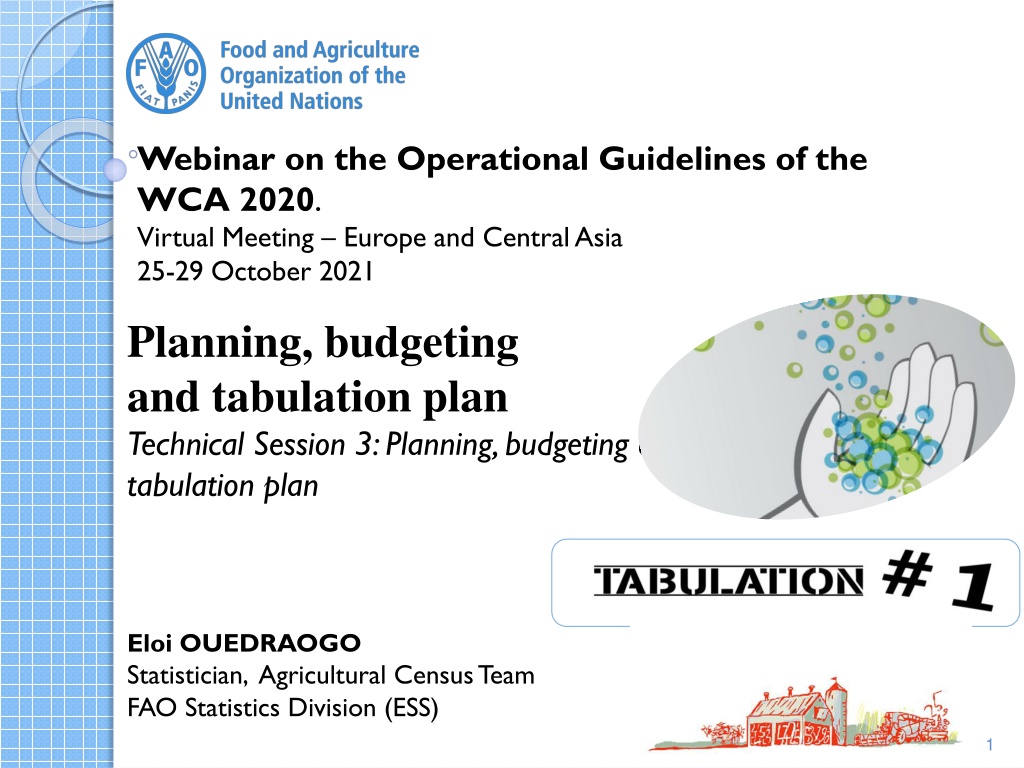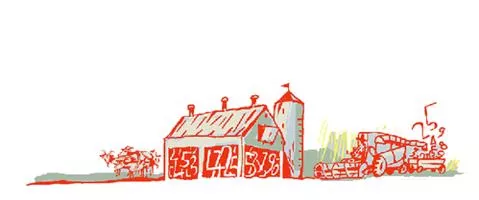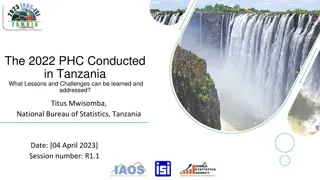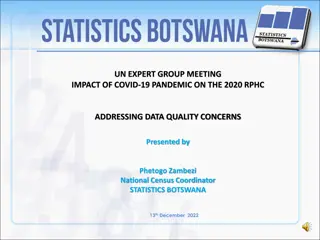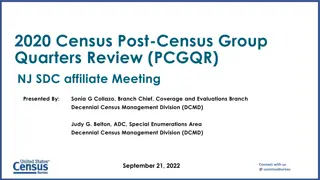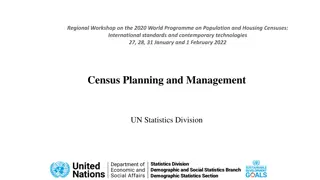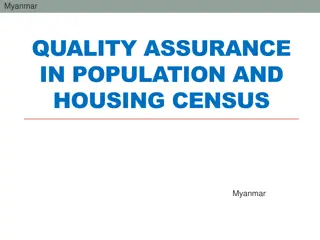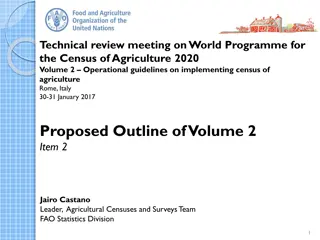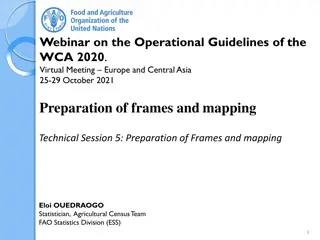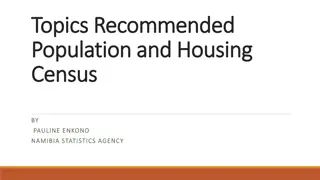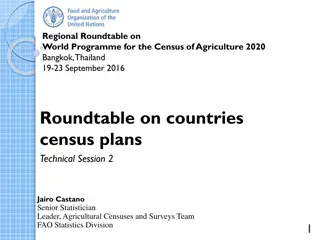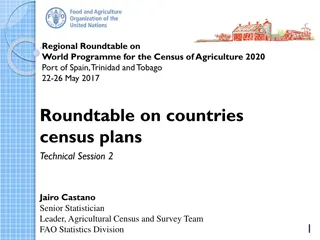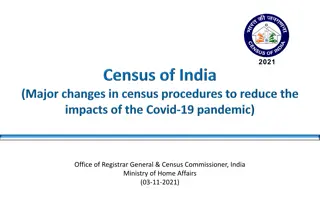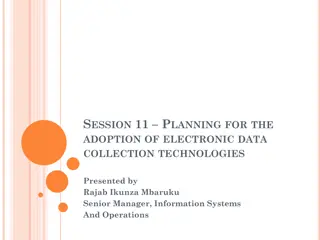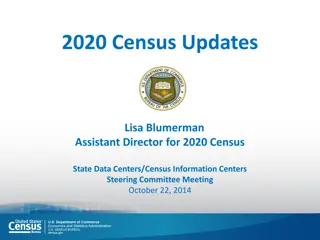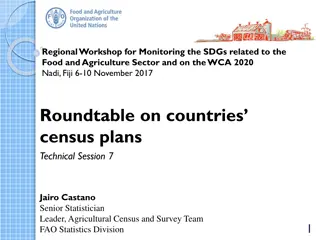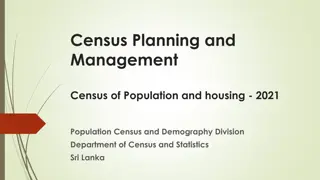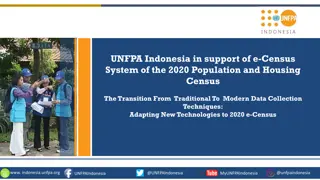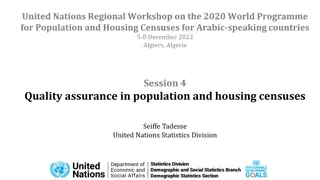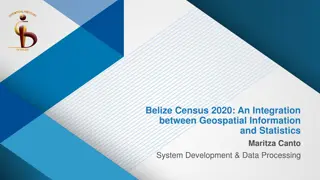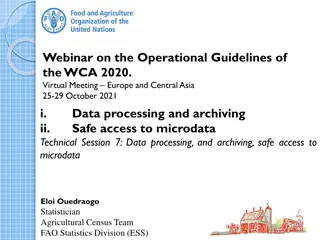Operational Guidelines of WCA 2020 Census Work Plan
Learn about the operational guidelines for the WCA 2020 census work plan, covering topics such as planning, budgeting, tabulation, and more. Explore the phases, activities, and tasks involved in preparing for a successful census. Understand the importance of cost-effectiveness and realistic budget estimates in complex statistical operations like agricultural and population censuses. Gain insights into the key milestones, activities, and responsibilities in the work plan. Plan effectively for a comprehensive and accurate census process
Download Presentation

Please find below an Image/Link to download the presentation.
The content on the website is provided AS IS for your information and personal use only. It may not be sold, licensed, or shared on other websites without obtaining consent from the author.If you encounter any issues during the download, it is possible that the publisher has removed the file from their server.
You are allowed to download the files provided on this website for personal or commercial use, subject to the condition that they are used lawfully. All files are the property of their respective owners.
The content on the website is provided AS IS for your information and personal use only. It may not be sold, licensed, or shared on other websites without obtaining consent from the author.
E N D
Presentation Transcript
Webinar on the Operational Guidelines of the WCA 2020. Virtual Meeting Europe and Central Asia 25-29 October 2021 Planning, budgeting and tabulation plan Technical Session 3: Planning, budgeting and tabulation plan Eloi OUEDRAOGO Statistician, Agricultural Census Team FAO Statistics Division (ESS) 1
Contents Census work plan Census budget Outsourcing tasks/census activities Monitoring and review of the work plan and the budget Expenditure control Tabulation Country example 2
Background Agricultural Census (AC) & Population and Housing Census (PHC) complex and expensive statistical operations. Work Plan & Budget - realistic estimates. Inadequate planning and/or underestimating the financial requirements are basic reasons for serious problems The complexity of the planned census modality should be carefully considered. Planning & Preparation- changes after the previous census. At least two-three years is required from the initial preparatory work to the dissemination of the final census results, even for a census in a small country. 3
Planning AC is regarded as a single project comprising a series of phases(broken down into activities and further into tasks): Preparatory work and testing Enumeration Data processing and building of databases Evaluation of the results Analysis, dissemination of census results and archiving. Census agencies should ensure cost-effectiveness from the beginning when choosing the census method and technology. Planning the census as inexpensively as possible without compromising the quality of results requires carrying out cost-benefit analysis. 4
Work plan The work plan (WP) indicates the sequence and estimated duration of each census activity. A provisional WP of selected milestones should be prepared as an overall framework for the census. Starting point: previous census WP, or similar operations (economic or PHC censuses). Provisional WP - shared with stakeholders for advice and support. WP - chart identifying all the key census activities grouped into census phases or steps. The activities can be broken down into tasks to establish resource estimates, responsibilities and confirm dependencies and timing of interrelated tasks. Each phase and activity would have someone responsible for it. It is often practical to develop a General WP and a detailed WP. 5
Year 1 Q2 Year 2 Year 3 Q2 Year 4 Q2 Example of General Work Plan Q1 Q2 Q3 Q4 Q1 Activity Q1 Q3 Q4 Q3 Q4 Q1 Q3 Q4 Pre-enumeration Update the census legislation Form a census steering committee Design and implementation of the communication and publicity strategy User-producer workshop Tabulation plan Development of the census methodology and questionnaire design Manuals Pilot census Preparation of frame/holding listing Printing census questionnaires and other materials Distribution of materials Recruitment of field staff Training Enumeration Field data collection Receipt of questionnaires and other materials from field staff and their delivery to the CCO Post-enumeration Post-Enumeration Survey Preliminary results Data processing - data coding and data capture - editing and validation - tabulation Analysis and dissemination - thematic analyses - production (including printing) of census reports and of other dissemination products (CDs, maps, etc.) - national seminar and other public events to disseminate census results - online dissemination Archiving of census data and materials 6
Work plan (contd) Detailed WPs - for main census activities such as publicity campaign, procurement, training, field enumeration, data processing and dissemination. The census managers must ensure consistency of detailed WPs with the general WP. The length of each activity must rely on realistic information from the previous AC or similar operations (e.g. most recent PHC). Pilot census, should be used for adjusting the estimation of time and resource requirements. It is a good practice to have a fully dedicated employee dealing with development, monitoring and updating the census WP, and preparation of progress reports. Make use of known and common tools, such as: Program Evaluation and Review Technique Project management software (e.g. Gantt chart). 7
Work plan (contd) Avoid overlapping with large scale societal events (elections or referendums) Plan the enumeration period according to the agricultural season (to ensure the collection of reliable primary census data) Ensure availability of resources in a timely manner (e.g. funds for the remuneration of field staff) The financial rules and regulations in some countries put a major constraint on census salaries/allowances to field staff in time. Moving the money to the field is a big challenge in some countries. At planning and budgeting stage, there is needed to have a discussion with financial services on the practical solutions to be made for smooth implementation of field operations. managers to pay 8
Census budget Recommendation: cartography, enumeration, processing, post-enumeration survey, analysis and dissemination, be budgeted from the beginning and efforts made to mobilize the required funds. A financial outline is drawn up from the WP and two kind of costs should be distinguished: Variable costs, for which the total cost derives directly from the product of a unit cost and a physical quantity. Fixed costs, that are not dependent on output. Assessments of time and of cost must be based on real prices for products and services and estimates. The budget should have built in some contingency allowance for inflation and unexpected expenses, such as higher transportation costs. Ways of estimating budgets: Based on the previous AC, brought up to current prices; Based on the previous expenditure pattern, again adjusted as above; Estimated using costing models. All census operations, including planning, 9
Census budget (contd) The field work, processing and dissemination of census data are the principal budget components of the census operation. Transportation cost may also be a major component. The amount of field work will determine the amount of processing and dissemination. A balance has to be determined between the resources spent on these components. With poor planning it often happens that a disproportionately large percentage of the total budget is spent on data collection and not enough funds are left for processing, tabulation analysis and dissemination. Budget estimation may be helpful to prepare for each province separately and then pool them together to arrive at a country estimate. 10
Outsourcing some tasks/census activities Outsourcing tasks based on the following criteria: Strict protection of data confidentiality Guaranteed measures of quality assurance Control over the core competence of the census agency. Activities that may be considered for outsourcing include: cartography and mapping communication and publicity campaign layout and printing of census questionnaires census publications/dissemination products packing and delivery questionnaires and other census material, and equipment ICT systems development collection, processing and dissemination Scanning/data entry. Core census activities should not be outsourced: preparation of census frame, design and questionnaires, census enumeration, analysis, preparation of census reports, dissemination results and archiving test of of census of census for data 11
Outsourcing(contd) Activities to be outsourced must be clearly defined and contracts well prepared with clear deliverables and timelines. The contract should specify the TOR clearly along with timelines, milestones, delivery schedules and dispute resolution clauses and selection based on competitive bidding. The census agency needs to continuously monitor and ensure the quality of the census results. Outsourcing activities does not relieve census managers of their responsibility. 12
Monitoring and review of the WP & budget Monitoring systems must be developed with a continuous review of the progress of work to ensure that day-to-day operations are proceeding smoothly and as planned. It is recommended that, while budgets may be compiled on a yearly basis, they should be monitored on a quarterly or monthly basis, with projections of the total expenditures for the current financial year. Each phase s performance should be monitored against budgeted funds. If control measures and monitoring systems are already in place in the organization, they should be used. Some countries use change management structure approach for identifying, evaluating, planning and integrating changes during the life cycle of a programme (e.g. the example of Canada related to Change Management). 13
Expenditure control Transparent accounting procedures and financial management systems should be implemented by the central census office (CCO) in accordance with the national legislation and requirements of the funding agency. This would enable prompt release and control of allocations of census funds to the CCO and to provincial and district offices. Progress report system is desirable to be developed at regular intervals, say once a quarter or month. Progress reports should be compatible with the form in which both the WP and the budget have been prepared. 14
Tabulation plan Definition: a set of prototypes of statistical tables (template tables) prepared to present the main census results, based on the users primary needs. Importance: paramount for developing the census questionnaire and to ensure that all relevant census information is included. needed for planning and organizing the data processing and tabulation of census results. Recommendations: the tabulation plan should start in consultation with users, when census contents and census methodology are discussed with the main stakeholders. The census tables (priority and standard) responding to the needs of users should be defined In addition to the tabulation plan, customized tabulations, may be produced on demand using census databases. 15
Tabulation plan (contd) Coherence and comparability (with): previous censuses (when available) other statistical data relevant and reliable administrative data sources (land cadaster information, agricultural machinery, organic farming, etc.) international comparability (including the use of recommended classifications/ tabulation classes). The preparation of the tabulation plan is an iterative process: census questionnaire and census methodology are conditioned by the data to be tabulated and vice versa. If sample enumeration is used, tabulation for small areas or for rare items will not be possible because of large sampling errors. 16
Standard statistical tables Totals for items collected, such as total area of holdings according to land use (or land tenure), types or number of animals for each livestock type. Total number of units with certain characteristics, such as the number of holdings with agricultural land and livestock or both. Averages for items, such as the average area of the holding or number of parcels per holding. Percentages (e.g. of holdings using organic fertilizers or with animals). 17
Classification variables Are characteristics used for data tabulation. Nine main classification variablesareidentified for tabulations of the essential items: 1. Administrative unit or agro-ecological zone 2. Legal status of agricultural holder (type of holder) 3. Total area of holding 4. Area of agricultural land (as well as by main land use classes, e.g. arable land, land under permanent crops) 5. Number of livestock (for a particular livestock type) 6. Main purpose of production of the holding 7. Household size by sex and age group 8. Sex of agricultural holder 9. Age of agricultural holder. 18
Tabulation classes Often, classification variables are formed into suitable classes for presentation in the tables. WCA 2020 recommends to use census essential items for the tabulation classes. Examples: Essential item/classification variable Tabulation classes Legal status of agricultural holder (type of holder) A civil person Group of civil persons Juridical person Holder is a civil person Under 25 years 25 34 years 35 44 years 45 54 years 55 64 years 65 years and over Joint holders Age of agricultural holder 19
Tabulation classes (contd) Consistency between statistical collections in the country (e.g. using the same age groups (for ex. 25-34, 35-44, etc.). International standards: countries should adhere to those wherever possible to help in making comparisons between countries. To meet national reporting needs, more disaggregated classes are encouraged (to allow for re-aggregation). Where countries wish to use different class groupings in their reports, they should also report according to groupings given in the WCA 2020 for international comparison purposes. For more details see WCA 2020, Vol.1, Table 1. Agricultural census essential items: tabulation classes. 20
Territorial profile of census results Different levels, by: administrative regions agro-ecological zones villages/communities other small areas Dissemination of data items which are relevant, meaningful for a particular level and ensuring data confidentiality. The level of administrative units to be presented in the tables could be a decisive factor in designing: census methodologies (choosing between complete or sample enumeration, defining agricultural holding within the border of a region) census tools e.g. questionnaires with special sections or annexes completed for administrative units where land and/or livestock is located. 21
Cross-tabulations There are basic cross-tabulations presenting different types of summarized measures. Two-way tables: census data are classified by two different items simultaneously, e.g.: number of holdings classified by area of holding and livestock (by each area/livestock number class) number of holdings classified by age of holder and area of holding (by each age/area class) There are also more complex cross-tabulations like three-way tables (e.g. number of holdings classified by age of holder, area of holding and province). For more details see WCA 2020, Vol.1, Table 2: Agricultural census essential items: recommended cross-tabulations. 22
Tabulations: census scope and coverage Agricultural (crop and animal) production activities correspond toISIC groups 011- 015. Interpreted very broadly: agricultural, forestry and/or aquaculture and/or fisheries production activities. Widened census: includes both agricultural and non- agricultural production households. Community-level data collection in an agricultural census. Tabulationswith more details on some sub-populations of holdings (such as large or special holdings ). 23
Tabulations: community-level data Community-level data in an agricultural census can be tabulated in two ways: To summarize the characteristics of communities To use as classification variables for tabulations against holding-level data, such as number and area of holdings and number of households and population. Typical community-level classification variables are: Access to urban centre Risk of natural disasters Economic status Occurrence of seasonal food shortages Presence of a periodic or permanent agricultural produce market Access to veterinary services Access to farm input trading centre Access to credit institutions Access to farmers association Presence of specific development projects 24
Example CENSUS WORK PLAN - General Census ofAgricultural 2011 - Moldova 25
Country example - 2010 Census of Agriculture UK Census report The census of agriculture and horticulture (June 2010) conducted under the European law had a questionnaire with 6 sections: Land area in the holding; Grassland and non-agriculture land area; Crop and fallow land area; Horticulture area; Livestock number; People working in the holding. Several reports were produced.The main ones were the 'Land use and livestock on agricultural holdings' and 'Labour on agricultural holding on 1 June'. For the 'Land use and livestock on agricultural holdings . 11 tables were published in the annex and the body of the report comprised text on analysis of data covering, land use and utilized area, croppable area by type of crop and livestock number by type of livestock. Analysis was supported by figures and maps. 30
Country example - 2010 Census of Agriculture UK Census report The tables in the annex of the report on 'Land use and livestock on agricultural holdings' were: Table 1 Summary of land use on agricultural holdings; Table 2 Area of owned and rented land on agricultural holdings; Table 3 Arable crops; Table 4 Fruit and vegetables grown in the open; Table 5 Hardy Nursery stock; Table 6 Glasshouses and protected crops; Table 7 Cattle and calves in agricultural holdings; Table 8 Pigs on agricultural holdings; Table 9 Sheep and lambs on agricultural holdings Table 10 Poultry agricultural holdings Table 11 All other livestock on agricultural holdings 31
Country example - 2010 Census of Agriculture UK Census report The report on the 'Labour on agricultural holdings' had the same structure as the report on 'Land use and livestock on agricultural holdings' with two tables in the annex: Table 1 Number of people working on commercial agricultural holdings; Table 2 Number of people working on agricultural holdings. 32
THANK YOU! 33
